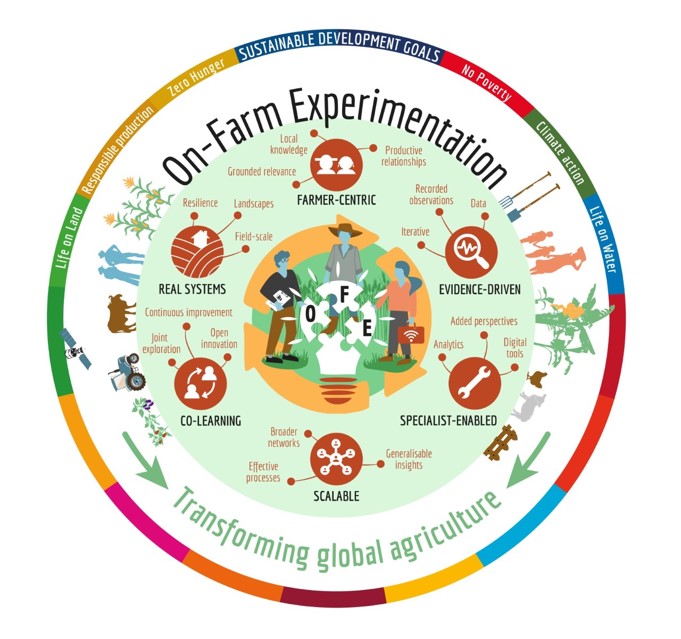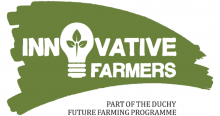See the Farm Centric Research page for more info. Add any activities using on-farm experimentation below.

On Farm Experimentation (OFE) is increasingly being recognised as having transformative power in improving performance in agricultural systems across the world.
Recommended Content
- Nature Food paper on On Farm Experimentation
- Establishing the precision and robustness of farmers’ crop experiments
- Supporting and analysing on-farm Nitrogen tramline trials so farmers, industry, agronomists and scientists can LearN together
- Successful approaches for on-farm experimentation
- Farm-PEP
- YEN
- FLIN Farmer-led Innovation Network
Content below is from across the PEP community and is not necessarily endorsed by Stewards or by PEP
Connected Content
The Yield Enhancement Network (YEN) was launched in 2012 to support and energise on-farm learning-by-sharing and thus to enhance farming progress.
The Farmer-Led Innovation Network (FLIN) are UK based organisations driving farmer-led innovation - working together to power up and increase the impact of farmer led innovation initiatives.
At this years Agri-Tech E REAP Conference, Sarah Kendall, ADAS Crop Physiologist joined a panel consisting of Matthew Smith (Scientific Technologies) and Macelo Galdos (Rothamsted Research) to discuss how the digital world is informing and guiding the developments and decisions in the real world – ranging from digital twins to predictive models, from platforms to help with scenario planning to the use of AI and machine learning to yield unprecedented insights into the future of agriculture and horticulture.
Agronomics is the science of understanding the variation in the cropped environment, identifying the management practices and system designs that work. It uses a farm centric approach of shared farm data and on-farm experimentation.
Farmers taking part in and getting paid for on-farm trials as part of the NCS Project.
Supporting farmers with robust design and analysis of on-farm experiments in tramline trials.
Farm-centric research generally involves On-Farm Experimentation and may be better described as 'Farm Action Research', i.e. research conducted at least in part by and for beneficiaries who also farm.
The British On-Farm Innovation Network A network of farmers who carry out their own on-farm trials and share the results, seeking a scientifically robust way to progress farm practice.
Slug-Resistant Wheat A project to explore the properties of Watkins 788, a landrace wheat believed to be resistant to slugs, never before been grown in the UK.
The ideas behind Farm-PEP came together in ~2018, drawing from the developments of Agronomics, the YENs, AHDB's Monitor Farm programme and the idea of a 'What Works' Centre for Agriculture.
Farmers, advisors and researchers working together to understand and improve crop nutrition on-farm
Inferring the right conclusions from field trials is important - how confident can you be that a result is 'real' rather than due to the underlying noise? As part of the Farm-PEP FIP project we are working with BGS to explore the best ways to communicate confidence, uncertainty, significance, probability and value with farmers and growers.
ADAS have produced a new guide with our five top tips for successful on-farm trials. We'd love you to give it a try and to hear about what products or approaches you're testing on farm - by sharing the results of trials, we can learn more together.
Our PulsePEP trial will evaluate the novel method of bi-cropping spring peas, spring oats and spring beans in a rotation, looking at the impact on available nitrogen (N) in the following crop. It will also evaluate the environmental benefits of including pulses in a rotation, by measuring greenhouse gas emissions, particularly nitrous oxide (N2O), over the course of the experiment.
Innovative Farmers has now been running for a decade, facilitating farmer-led research to some of
Paper in Agronomy, 2021 by Jason B. Cho, Joseph Guinness Tulsi Kharel, Ángel Maresma, Karl J
The development of Farm-PEP Performance Enhancement Partnerships to support on-farm knowledge generation through shared ideas, data and experimentation. Funded as part of Farming Innovation Pathways programme from Defra and Innovate UK Transforming Food Production.
AICC Advisors and farmers testing appropriate nitrogen rates and strategies for reduction in light of current high prices. Brought together by the FarmPEP FIP project
Precision farming involves the use of GPS, sensing and control technologies to use spatial data to manage soils, crops and livestock.
Many of the most telling innovations that make a difference on-farm come from farmers themselves, or from close collaboration between farmers, advisors, industry and researchers
The INNO-VEG project aims to increase the speed and uptake of innovation in the field vegetable and potato sectors by: Defining and implementing a new approach for delivering cost-effective research. Establishing a cross border innovation network which will create the framework conditions for innovation to facilitate uptake of the new approach.
Direct Driller is a new farming magazine, designed by farmers for farmers to educate and inform the industry about direct drilling and no-till techniques, soil regeneration and soil conservation in arable and mixed farming situations. Direct Driller Magazine is available free to all farmers and agronomists who register with us and can be received in the post or via email depending on your preference. The key aim of Direct Driller is to help farmers to take back control of their farms and businesses and find a way of growing healthy crops using minimal effort and the correct inputs. It will be content put on by farmers, for farmers. We will showcase all the latest machinery and techniques, but the core of the Magazine is all about the soil and how you can use machinery, inputs and biology to improve it.
Farmer Innovation Group as part of the YEN Yield Testing EIP Agri project Amino acids have been widely reported in the farming press and in a few scientific papers to be biostimulants, but with little or no independent evidence from UK field conditions. This Amino Acid FIG was established to put that right, making eight tests in 2018 and five more in 2019.
Guidance from ADAS Agronomics on how best to conduct Line Trials on farm.
Hybrid conference held in Montpellier in October 2021 exploring Farmer Centric On-Farm Experimentation.
Scientific paper in Field Crops Research published by the ADAS Agronomics team reporting experience working with BASF Real Results farmers conducting around 50 on-farm Line Trials per year.
Prompted by conversations on twitter this page is to explore where rates of nitrogen on-farm can be reduced whilst soil organic matter levels and yields are increased, using regenerative agriculture practices.
As part of the AICC Crop Nutrition Club 2023, this on-farm sugar beet trial tested the effects of applying Blue N and the extent to which its use can compensate for a reduced N rate. The trial was facilitated by a local AICC advisor, with support and Agronomics analysis of Sentinel2 satellite imagery by ADAS.
Scientific paper just published: Roques, S., Kindred, D., Berry
Our vision for Farm-PEP was summarised at a conference addressing "On-Farm Experimentation" (at M
Within our Farm-PEP Innovate UK project we are looking to develop 'patch testing' as an approach
The AHDB Recommended List is part of the fabric of arable farming and is the engine drivi
Final report from the Automating Nitrogen Defra LINK project 2010-2015 with AHDB, ADAS, AgLeader,
Defra Sustainable Arable LINK project from 2010 to 2015 that aimed to produce an automated system using precision farming technologies for N management of cereals, but ended up changing the whole way we think about nitrogen, yields, experimentation, research, variation & knowledge.
Farmer Innovation Group as part of YEN Yield Testing project on achieving Deeper Rooting. Encouragement of deep burrowing earthworms might enhance yields by enabling deeper rooting, and capture of more sub-soil water.
AHDB project from 2014-2018 working with farmers to monitor and optimise their nitrogen fertiliser rates on-farm.
How do you conduct and manage robust research and development at scale on your farm? What are the best methods for data collection and analysis? What are the best approaches to collaborative projects with researchers? Join us on April 28th as we explore the scientific approaches to on-farm trials and how to work more effectively with researchers.
BASF Real Results Circle (https://basfrealresults.co.uk/) has been running since 2017, bringing together 50 farmers and supporting them to test decisions on-farm.
Farmer Innovation Group from the YEN as part of the YEN Yield Testing Project. The idea of crop momentum arose because high yields in the YEN associated with little-and-often applications, or ‘attention to detail’. Also, two interacting factors are thought to drive crop growth: assimilate supply (source), and assimilate storage capacity (sink). It was suggested that the initial source may affect the sink at the next stage; so increasing initial growth may enhance subsequent growth, creating ‘momentum’.
Farmer Innovation Group as part of YEN Yield Testing EIP Agri project testing spring potassium fertiliser applications
Group coming out of the YEN looking at ways to increase deep rooting, by encouraging deep burrowing earthworms.
As part of the AICC Crop Nutrition Club 2022, this on-farm winter oats trial tested the effects of applying Utrisha N. The trial was facilitated by a local AICC advisor, with support and Agronomics yield map analysis from ADAS.
As part of the AICC Crop Nutrition Club 2022, this on-farm winter wheat trial tested the effects of applying Utrisha N at two contrasting N rates. The trial was facilitated by a local AICC advisor, with support and Agronomics yield map analysis from ADAS.
Scientific Paper by Rob Bramley, Simon Cook and colleagues in 'Agronomy for Sustainable Development' 2022.
Long-term experiments (LTEs) are valuable resources to assess the sustainability and resilience of agricultural practices and systems.
As part of the AICC Crop Nutrition Club 2022, this on-farm winter wheat trial tested two biostimulants (3 Alo T6P and Nutrino Pro) applied as a tank mix with fungicides at the T3 timing. The trial was facilitated by a local AICC advisor, with support and Agronomics yield map analysis from ADAS.
As part of the AICC Crop Nutrition Club 2022, this on-farm winter wheat trial compared N rates from 140 to 260 kg/ha, including the N rate recommended by the Yara N tester. The trial was facilitated by a local AICC advisor, with support and Agronomics yield map analysis from ADAS.
As part of the AICC Crop Nutrition Club 2022, this simple on-farm winter wheat trial in Nottinghamshire tested the yield effect of reducing N rate from the 'farm standard' of 220 kg/ha to 170 kg/ha. The trial was facilitated by a local AICC advisor, with support and reporting from ADAS.
As part of the AICC Crop Nutrition Club 2022, these two on-farm winter wheat trials tested whether the N inhibitor Didin can sufficiently slow N release to allow the whole season's N fertiliser to be applied as UAN in a single split. The 'farm standard' control treatment consisted of the same N rate applied as UAN over three split timings without an inhibitor. Trials were facilitated by a local AICC advisor, with support and Agronomics yield map analysis from ADAS.
At Groundswell, join us at the Innovative Farmers stand from 12-1 on Thursday 29th June for a clinic on Farm trials: how to make the most of them. A chance to share experiences and have your questions answered by ADAS and IF experts
As part of the AICC Crop Nutrition Club 2022, this on-farm winter wheat trial compared N rates from 140 to 260 kg/ha, including the N rate recommended by the Yara N tester amd one treatment with additional Poly N Plus. The trial was facilitated by a local AICC advisor, with support and Agronomics yield map analysis from ADAS.
The Global On-Farm Experimentation Network has been set up to connect OFE communities worldwide. GOFEN is setting up a directory of organisations and actors with an interest in OFE. It will be launched at the OFE 2023 conference in December 2023.
The trial will evaluate the long-term effects of pulses in an arable rotation, particularly the effect on available N to following crops. Objectives are: To evaluate the effects of winter beans, winter bean/ winter wheat intercrop and spring beans on soil nitrogen supply annually over 5 years. To evaluate the effects of species and species mixtures on GHG emissions. To evaluate impacts on soil structure and health resulting from cropping differences.
Join us to explore the pros and cons of facilitating farm trials.
Perennial Green Manures are trees, shrubs and perennial plants grown in permanent areas to provide nitrogen-rich leaves to fertilise horticultural and arable land.
The demo design guide summarizes in 6 steps how to design an on-farm demonstration event, starting from a clear definition of the objectives and ending with a good evaluation and follow-up.
As part of the AICC Crop Nutrition Club 2023, this on-farm winter wheat trial tested the benefits of clover living mulches in winter wheat. The trial was facilitated by a local AICC advisor, with support and Agronomics yield map analysis from ADAS.
As part of the AICC Crop Nutrition Club 2023, this on-farm winter wheat trial compared the effects of using two different drills, a Väderstad Rapid and Horsch Sprinter. The trial was facilitated by a local AICC advisor, with support and Agronomics yield map analysis from ADAS.
As part of the AICC Crop Nutrition Club 2023, this on-farm winter wheat trial tested the effects of applying Nutrino Pro foliar N at T2 and T3. The trial was facilitated by a local AICC advisor, with support and Agronomics yield map analysis from ADAS.
Join us for The BOFIN Dinner, a night of sharing latest innovations, invaluable insights and delicious food!
In this Field Lab two farmers in Scotland have teamed up with soil expert, Audrey Litterick, Earthcare Technical, to see if there are practical benefits to using bokashi – treating manure with microorganisms that break down animal bedding and dung – over a 3-year period.
Because successful and sustainable agroforestry practices are best developed by farmers and land owners working in partnership with researchers, extension staff, and other rural businesses, AGFORWARD used a participatory approach to ensure the effective involvement of all these stakeholders. These leaflets provide summaries of key innovations to systems.
As part of the AICC Crop Nutrition Club 2023, this on-farm spring barley trial compared the effects of using two different drills, a Kverneland TS Evo and Horsch Sprinter. The trial was facilitated by a local AICC advisor, with support and Agronomics yield map analysis from ADAS.
As part of the AICC Crop Nutrition Club 2023, this on-farm winter wheat trial tested the effects of applying L-CBF Boost liquid carbon fertiliser. The trial was facilitated by a local AICC advisor, with support and Agronomics yield map analysis from ADAS.
Be amongst the first to hear about the findings from Year 1 of the NCS and TRUTH projects!
Scientific paper in Field Crops Research (2018) by Ben Marchant of BGS and ADAS colleagu











